Article
Boyko L.A., Tereshchenko L.V., Velichkovsky B.B., Latanov A.V. (2019). Visual-motor activity of professional pianists at sight-reading music. Moscow University Psychology Bulletin, 2, 3-26
Abstract
Relevance. The musical activity of a professional pianist has been little studied by objective methods. For most musicians, the task of sight-reading causes a difficulty in both academic and professional activities. Understanding the visual-motor mechanisms and cognitive processes involved in the implementation of sight-reading can help musical pedagogical practice. There are few sight-reading studies and most of them were conducted in conditions far from the real ones. This work is interdisciplinary that involved the interests of musical pedagogy, psychology and physiology.
Objective. On the base of the cognitive task of sight-reading music in conditions close to reality to explore the interaction of visual-motor parameters and their relationship with the parameters of the working memory.
Methods. 55 subjects aged 18–25 years (30 pianists and 25 non-pianists) were tested using the OS and N-back method to determine individual parameters of the working memory, as well as to determine the time of a complex visual-motor response. Eye tracking method was utilized for eye movement recording when the pianists sight read sheet of notes.
Results.The visual-motor performance parameters (eye hand span, errors and regressions) differ significantly at sight-reading musical fragments of varying complexity. Compared with the literature data we obtained opposite results for value of the eye hand span depending on the complexity of the musical text. We revealed correlations between the visual-motor parameters and the working memory parameters as well as their dependence on the quality of performance.
Conclusion. Objectively recorded visual-motor parameters complexly interact with each other. The mastery of sight-reading music of professional pianists closely related with individual parameters of the working memory.
Sections: Interdisciplinary studies;
Received: 12/26/2018Accepted: 01/14/2019
Pages: 3-26
DOI: 10.11621/vsp.2019.02.03
Keywords: sight-reading; eye movements; working memory; eye-hand span; music studies;
Available Online 30.05.2019

Pic. 1.
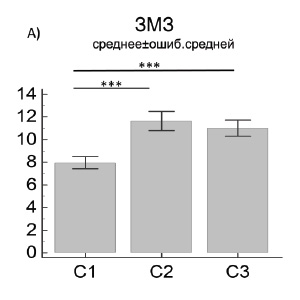
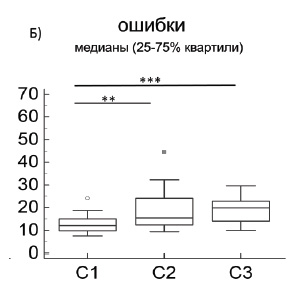
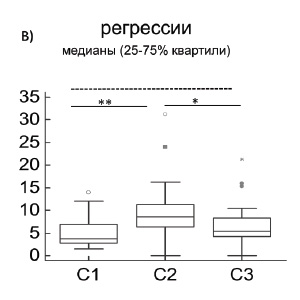
Pic. 2.
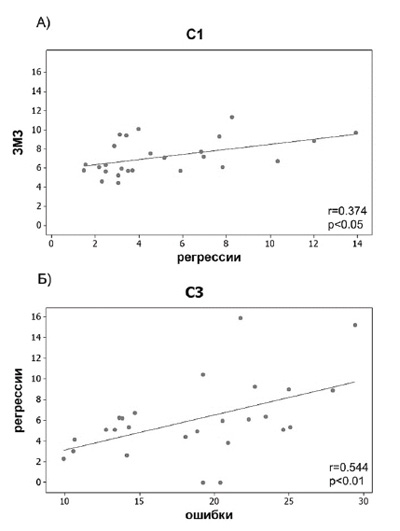
Pic. 3.
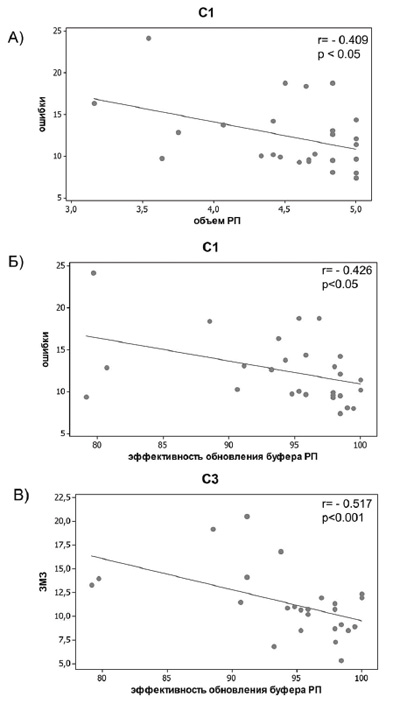
Pic. 4.
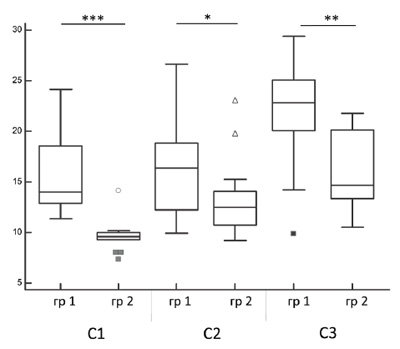
Pic. 5.
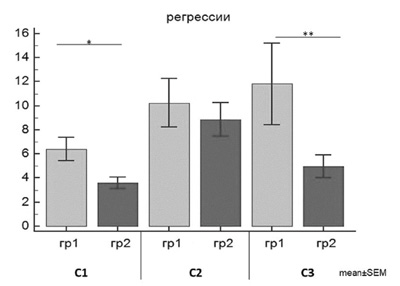
Pic. 6.
Allport, D.A., Antinis, B., Reynolds, P. (1972). On the Division of Attention: A Disproof of the Single Channel Hypothesis. Quarterly Journal of Experimental Psychology, 24, 225—235. doi.org/10.1080/00335557243000102
Anisimov,V.N., Fedorova,O.V., Latanov,A.V. (2014). Parametry dvizhenij glaz pri chtenii predlozhenij s sintaksicheskoj neodnoznachnost'yu v russkom yazyke [Parameters of Eye Movements when Reading Sentences with Syntactic Ambiguity in the Russian Language]. Fiziologiya cheloveka [Human Physiology], 40,5,57—68.doi.org/10.1134/S0362119714040033
Baddeley, A. (2003). Working Memory: Looking Back and Looking Forward. Nature Reviews Neuroscience, 4, 10, 829—839. doi.org/10.1038/nrn1201
Baddeley, A.D., Hitch, G. (1974). Working Memory. In G.H. Bower (ed.), The Psychology of Learning and Motivation (Vol. 8, pp. 47—89). N.Y.: Academic Press. doi.org/10.1016/S0079-7421(08)60452-1
Furneaux S., Land M.F. (1999). The Effects of Skill on the Eye-Hand Span during Musical Sight Reading.Proceeding of the Royal Society of London. Series B, 266, 2435—2440. doi.org/10.1098/rspb.1999.0943
Goolsby, T.W. (1994). Eye Movement in Music Reading: Effects of Reading Ability, Notational Complexity, and Encounters. Music Perception, 12, 1, 77—96. doi.org/10.2307/40285756
Kahneman, D. (1973). Attention and Effort. Englewood Cliffs, NJ: Prentice-Hall.
Kinsler, V., Carpenter, R.H.S. (1995). Saccadic Eye Movement while Reading Music. Vision Research, 35, 10, 1447—1458. doi.org/10.1016/0042-6989(95)98724-N
Levin, H., Kaplan, E.A. (1970). Grammatical Structure and Reading. In H. Levin, J.P. Williams (eds.), Basic studies on reading (pp. 222—245). N.Y.: Basic Books.
Mal'ter,L.I. (1972). Tablitsy po instrumentovedeniyu [Instrumentation Tables]. Moscow: Sovetskykompozitor.
Meinz, E.J., Hambrick, D.Z. (2010). Deliberate Practice is Necessary but not Sufficient to Explain Individual Differences in Piano Sight-reading Skill: The role of Working Memory Capacity. Psychological Science, 21, 7, 914—919. doi.org/10.1177/0956797610373933
Neubauer, A.C. (1997). The Mental Speed approach to the Assessment of Intelligence. In J. Kingma, W. Tomic (eds.), Advances in Cognition and Educational Practice: Reflections on the Concept of Intelligence (V. 4, pp. 149—174). Greenwich, CT: JAI Press.
Owen, A.M., McMillan, K.M., Laird, A.R., Bullmore, E. (2005). N-Back Working Memory Paradigm: Meta-analysis of Normative Functional Neuroimaging Studies. Human Brain Mapping, 25, 46—59. doi.org/10.1002/hbm.20131
Posner, M., Petersen, S. (1990). The Attention System of the Human Brain. Annual Review of Neuroscience, 13, 25—42. doi.org/10.1146/annurev.ne.13.030190.000325
Sedov, A.S., Popov, V.A., Filyushkina, V.I., et al. (2017). Cognitive aspects of human motor activity: Contribution of right hemisphere and cerebellum. Psychology in Russia: State of the Art, 10 (3), 206—217.
Sloboda, J.A. (1974). The Eye-Hand Span: An Approach to the Study of Sight-reading. Psychology of Music, 2, 4—10. doi.org/10.1177/030573567422001
Smith, D.J. (1988). An Investigation of the Effects of Varying Temporal Settings on Eye Movements while Sight Reading Trumpet Music and while Reading Language Aloud: Doctoral dissertation. Pennsylvania State University.
Souter, T. (2001). Eye Movement and Memory in the Sight Reading of Keyboard Music: Doctoral dissertation. University of Sydney, Australia.
Tereshchenko,L.V., Boyko,L.A., Ivanchenko,D.K.,et al. (2016). Chtenie muzykal'nogo teksta s lista pianistami: vzglyad nejrofiziologa [Reading a musical text from a sheet of pianists: a view of a neurophysiologist]. In V.A. Barabanshchikov (ed.), Procedury i metody eksperimental'no-psihologicheskih issledovanij. Ser. Integraciya akademicheskoj i universitetskoj psihologii [Procedures and methods of experimental-psychological research. Series: Integration of academic and university psychology] (pp. 339—344). Moscow: Publishing House "Institute of Psychology RAS".doi.org/10.17759/exppsy.2017100204
Tereshchenko, L.V., Boyko, L.A., Ivanchenko, D.K., et al. (2017). Harakteristiki muzykal'nogo ispolnenie i zritelno-motornogo vzaimodeistviq pri chtenii s lista u pianistov v zavisimosti ot osobennostej muzykal'nogo proizvedeniya [Characteristics of musical performance and visual-motor interaction when reading from a sheet of pianists, depending on the characteristics of the musical work]. Eksperimental'naya psikhologiya [Experimental Psychology], 10, 2, 40—53.
Truitt, F.E., Clifton,C., Pollatsek,A., Rayner,K. (1997). The Perceptual Span and the Eye–Hand Span in Sight Reading Music.Visual Cognition, 4, 2, 143—161. doi.org/10.1080/713756756
Turner, M., Engle, R. (1989). Is Working Memory Capacity Task Dependent? Journal of Memory and Language, 28, 127—154. doi.org/10.1016/0749-596X(89)90040-5
Velichkovsky,B.B. (2015). Rabochaya pamyat' cheloveka. Struktura i mekhanizmy [Working memory of a person. Structure and mechanisms]. Moscow: Kogito-Centr.
Velichkovsky, B.B. (2017). The concentric model of human working memory: A validation study using complex span and updating tasks. Psychology in Russia: State of the Art, 10 (3), 74—92.
Weaver, H.E. (1943). Studies of Ocular Behavior in Music Reading. I. A survey of visual processes in reading differently constructed musical selections. Psychology Monographs, 55, 1—30.doi.org/10.1037/h0093537
Young, L.J. (1971). A study of the Eye-movements and Eye-Hand Temporal Relationships of Successful and Unsuccessful Piano Sight-readers while Piano Sight-reading: Doctoral dissertation. Indiana University.
For citing this article:
Boyko L.A., Tereshchenko L.V., Velichkovsky B.B., Latanov A.V. (2019). Visual-motor activity of professional pianists at sight-reading music. Moscow University Psychology Bulletin, 2, 3-26








